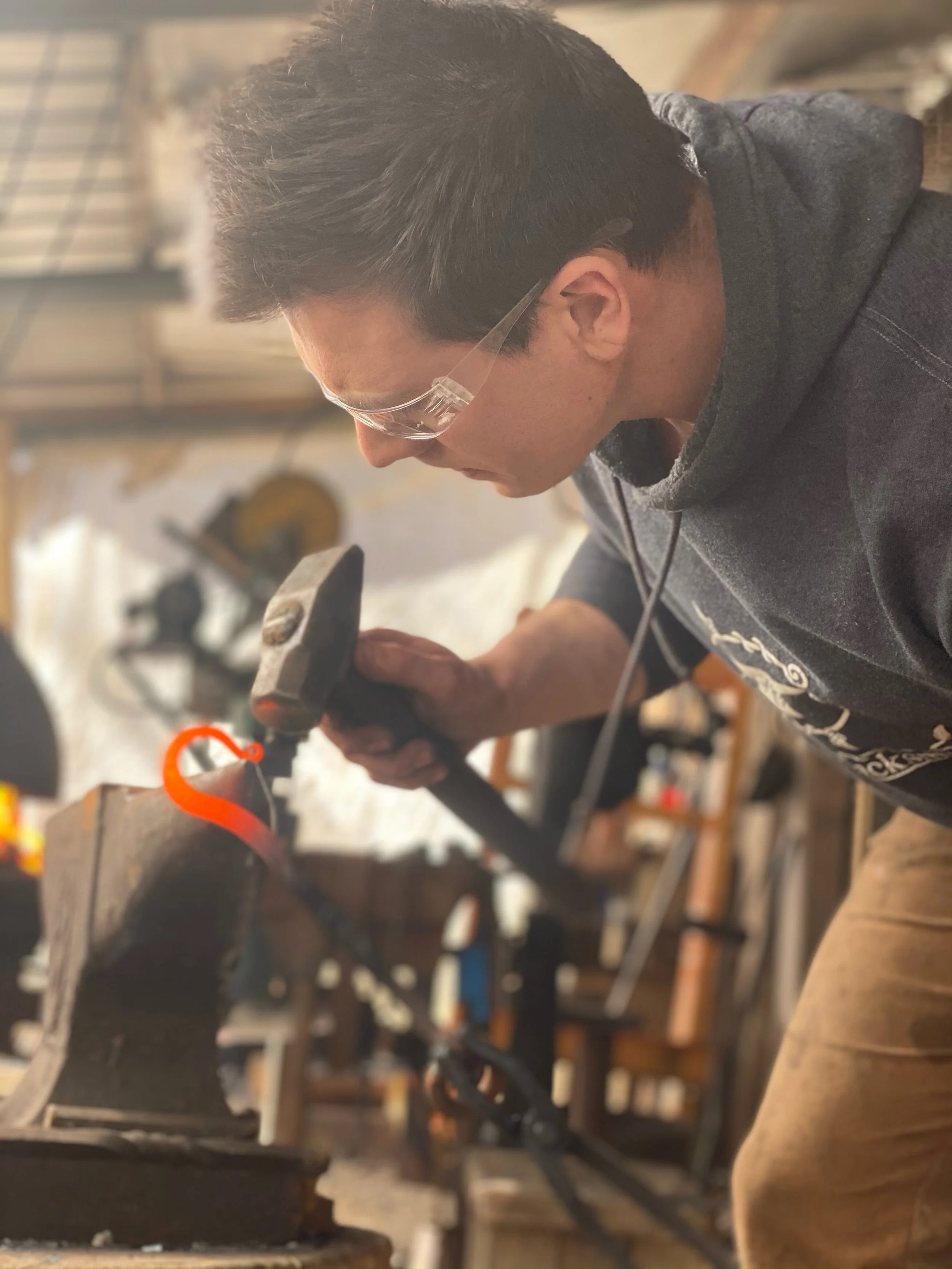
About Jesse
The Blind Blacksmith Artwork
Jesse’s art is inspired mostly by nature and wildlife. And even though he has lost much of his eyesight, the detail and craftsmanship in his work is outstanding. His goal is to make his items look realistic with an organic shape, and because precision is difficult due to his eyesight, his methods imbue a unique look and feel, one between realism and abstract.
Items in the photo gallery are available for purchase. In addition to the photo gallery items, Jesse also does custom pieces on consignment, so please feel free to reach out to us with those requests!
My Story
My name is Jesse C. Hall and I am “The Blind Blacksmith.”
At the age of five, I was diagnosed with Stargardt Disease, a rare eye disorder that causes central vision loss and affects about 30,000 people in the U.S.
I have no central vision and very blurred peripheral vision. I cannot easily recognize faces, read a book, or watch tv and I cannot drive. Everything is blurry whether I am looking at things in the distance or trying to focus on something up close, and I also have no depth perception.
As a teenager, I was unable to participate in activities like baseball or playing video games. I spent much of my time outdoors building treehouses, forts, and experimenting with simple machines. While attending a local festival I was inspired by a blacksmith; I was intrigued by the concept of shaping a metal bar with heat and hammer. I quickly researched and built my own coal forge and began to hone my blacksmith skills. This gave me the ability to forge my own tools and then I began to create - metal and wood sculptures, ornate railings, metal art, and custom home décor.
Jesse’s first coal forge
As I continued to grow and expand my craft, I acquired a sawmill, which allowed me to cut my own lumber and incorporate wood into my metal art, create live edge furniture, and even make custom props for movies, including a tribal axe for Jason Momoa!
In addition to my metal work and woodworking, I have earned my degree in Electrical Mechanical Engineering, am a cross country runner, health advocate, Eagle Scout and most recently I just finished deconstructing an 1884 farmhouse, piece by piece, with plans to build a house for myself using the reclaimed material.
“We should all strive to encourage ourselves, and others, to embrace challenges and pursue dreams no matter how discouraging it may seem at times.”
The daily challenges of being legally blind have NOT slowed me down. I rely on feeling what I cannot see and have adapted and devised techniques that help me create the intricate designs and details that encompass every piece I produce.
My work is inspired mostly by nature and wildlife. And even though I have lost much of my eyesight, I strive for detail and craftsmanship in every piece. I try to make my items look realistic with an organic shape and because precision is difficult, my finished work visually falls somewhere between realism and abstract.
We should all strive to encourage ourselves, and others, to embrace challenges and pursue dreams no matter how discouraging it may seem at times. Vision loss is an invisible and difficult disability and can be hard for people to understand, but I hope to raise awareness of it and be an inspiration to others through my endeavors.
About Stargardt Disease
Stargardt macular degeneration affects the retina, specifically a small area near the center of the retina called the macula. The macula is responsible for sharp central vision, which is necessary for detailed tasks such as seeing fine detail and color, reading, driving, recognizing faces and, for most people, the creation of art.
In addition to central vision loss, people with Stargardt Disease have problems with night vision, making it very difficult to navigate in low light.
Some also have impaired color vision, including problems distinguishing between greens and blues, oranges and reds, blacks and browns.
The signs and symptoms of Stargardt macular degeneration typically appear in late childhood to early adulthood and worsen over time.
There is no cure, and corrective lenses do not help, however; technology and research have come a long way over the last decade. There is a lot of research going on in stem cell and gene therapy that have shown positive results in early clinical trials, and technology like CCTV and accessibility options in all new computers and phones do help with independence.
Featured Media
-

World Equestrian Center Magazine
Featured in the 2019 Holiday Gift Guide in the WEC Magazine October 2019! Page 98
-

World Equestrian Center Magazine
Featured in the 2021 Holiday Gift Guide in the WEC Magazine VOL IV 2021! Page 82
-

Sidelines Magazine
I’ve had the opportunity to be featured in the May 2022 issue of Sidelines Magazine! Pages 40-43

Come visit Jesse at one of the many events and exhibits he will be at. See his pieces on display or see him in action as he forges brand new items on site.

